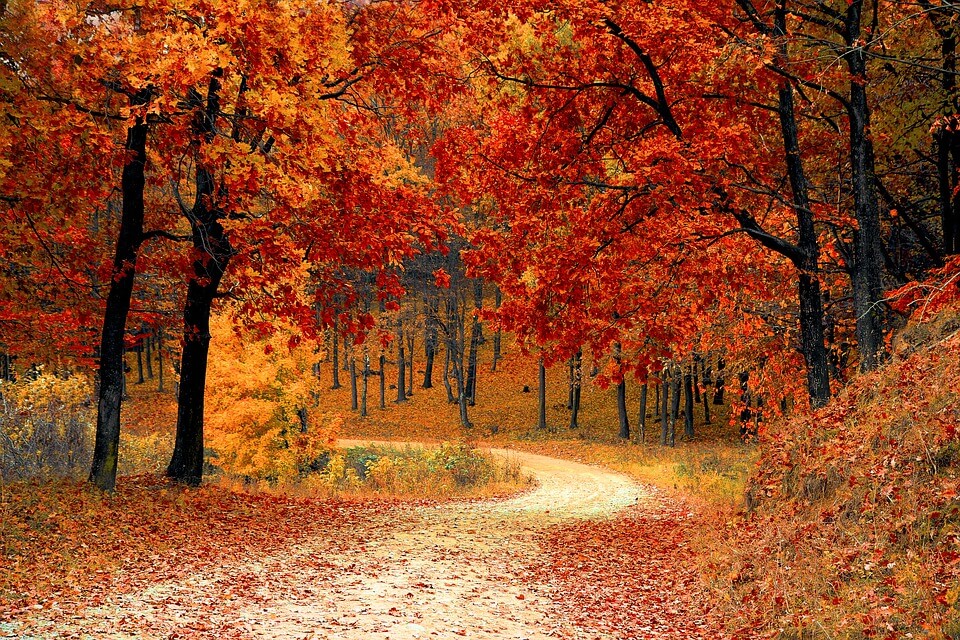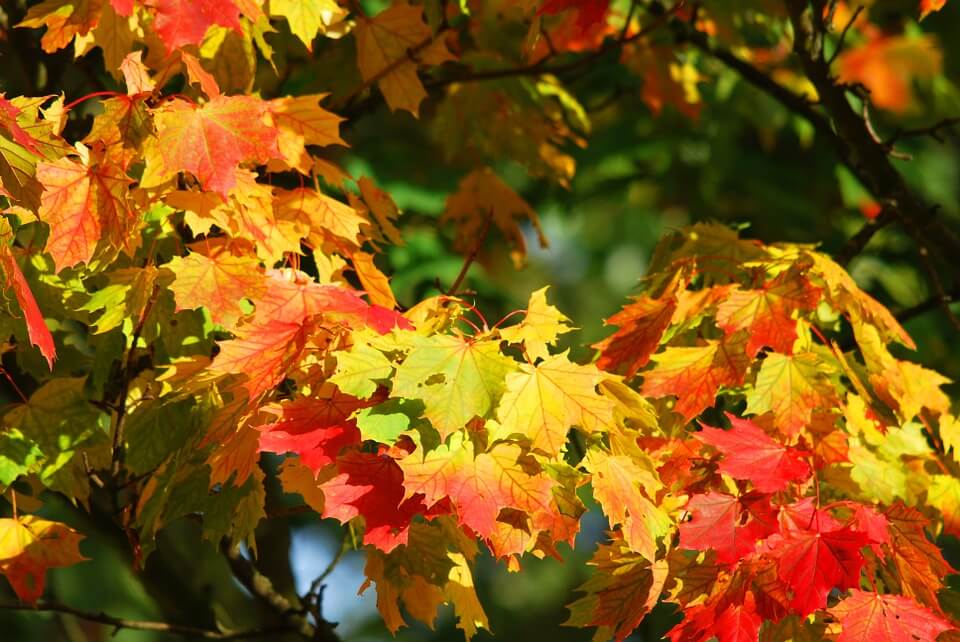
In sharp contrast to the frosty mornings and cold evenings, fiery hues and bright coloured fruit can liven up your Autumn. Cultivars of crabapple and rowan can produce pink, yellow and red fruit, which are perfect for wildlife, while maples and beech can create gorgeous palettes of red, orange and yellow. Now without further ado, either explore our Autumnal range of Plants For Autumn Colour or read more on six trees with fantastic autumn colour.
Maple Trees

An essential part of Autumn iconography, the red maple (Acer rubrum) can be found throughout the UK’s public parks. Introduced all the way back in 1656, the tree will produce a profusion of red, orange and yellow, before turning a vivid red. Highly versatile, the tree can be found growing in a wide range of conditions in its native North America and is suitable for urban settings as it is tolerant of pollution. See the popular Acer rubrum ‘Fairview Flame’ red maple tree.
Acer Trees

Unlike its larger cousin, the japanese maple (Acer palmatum) is suitable for all gardens and can be grown in containers. Indigenous to East Asia, the tree can be found growing at heights up to 1100m, hence its other name the mountain maple. Come Autumn, the tree’s dissected leaves will turn a deep red. The palmatum has many quirky cultivars including ‘Seiryu‘ with its cream-tinged green leaves that turn pale yellow; ‘Atropurpureum’ with bright orange Autumn foliage; and ‘Katsura’ with its gorgeous sunshine leaves and delicate foliage.
Nandinas Plants

An alternative to Autumnal tree, is the Nandinas Plants, also known as heavenly or sacred bamboo. Nandina plants are actually unrelated to the bamboo, nandina deriving from the Japanese “nanten” meaning problem solving. As a genus Nandina is comprised of only one species (Nandina domestica), making it monotypic. Despite the limitations of variety, the colour range is fantastic! Bright oranges, hot pinks, reds and yellows are found in these popular plants, see the beauty of ‘Fire Power’ and ‘Blush Pink’. The former produces unmatched fiery displays, the latter a mass of colour. Nandinas thrive when given space and are best left alone in a pot due to their extensive root systems. Possessing fantastic shape nandinas require minimal maintenance, but can become quite large – up to 2m.
The Sweet Gum

Similar to maple and beech, the sweet gum (Liquidambar styraciflua ) is notable for its conflagration of colour with its sharp five-pointed leaves turning red, yellow and purple. First introduced to Europe in 1681 by John Banister, one of the first university trained botanist, the species is also notable for deeply ridged bark, known as alligator bark in America.
Crabapples

Severely underrated, the humble crabapple will produce attractive foliage and bright and colourful fruits, which can last well into winter. The species is hardy, versatile and great for wildlife, being native to the UK. The tree will produce beautiful blossom come Spring and serves as a great pollinator for apples. Notable cultivars include ‘Butterball’, ‘John-Downie’, ‘Laura’ and ‘Red Sentinel’ with yellow, scarlet-orange, red and yellow-orange fruit respectively. Special is ‘Butterball’ that can produce six different colours throughout the year.
Rowan Trees

Similar to the crabapple, rowans produce fantastic coloured berries that can last well into winter, providing an essential source of sustenance for birds. Hardy and versatile the species is suitable for most soils, and with many different sized cultivars, there is a tree for every garden.The most famous is the native Sorbus commixta ‘Embley’ with red berries and slender leaves, which turn yellow in Autumn. Simply stunning, however, are the cultivars ‘Pink Pagoda’ and ‘Joseph Rock’. The former produces gorgeous pink berries, which are a favourite for birds, while the latter looks amazing with its deep red pinnate leaves contrasted with bright yellow berries.
Cherry Trees
 Commonly thought as a tree for Spring, many cherries are ideal ornamentals for Autumn hues. One of the best has to be the ‘Autumnalis Rosea’ that will flower intermittently from November to April with clusters of small semi-double rosy-pink blossom. Other varieties such as ‘Fragrant Cloud’, ‘Okame’ and ‘Umineko’ will produce fiery displays, with the Sargents among the first trees to colour up. ‘Fragrant Cloud’ is especially beautiful with its upright form. Worthy of note is the ‘Tibetan Cherry’ with its smart coppery-brown bark that will look beautiful regardless of season.
Commonly thought as a tree for Spring, many cherries are ideal ornamentals for Autumn hues. One of the best has to be the ‘Autumnalis Rosea’ that will flower intermittently from November to April with clusters of small semi-double rosy-pink blossom. Other varieties such as ‘Fragrant Cloud’, ‘Okame’ and ‘Umineko’ will produce fiery displays, with the Sargents among the first trees to colour up. ‘Fragrant Cloud’ is especially beautiful with its upright form. Worthy of note is the ‘Tibetan Cherry’ with its smart coppery-brown bark that will look beautiful regardless of season.
–
Jorge works in the Primrose marketing team. He is an avid reader, although struggles to stick to one topic!
His ideal afternoon would involve a long walk, before settling down for scones.
Jorge is a journeyman gardener with experience in growing crops.